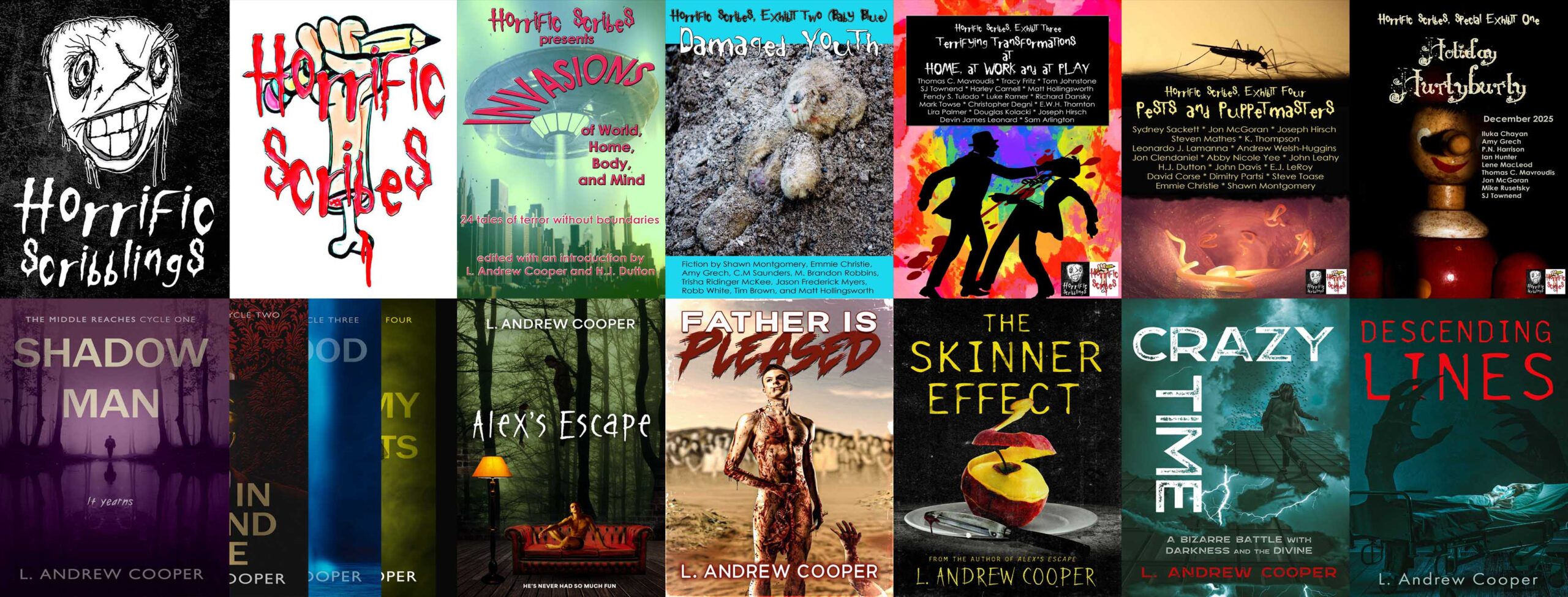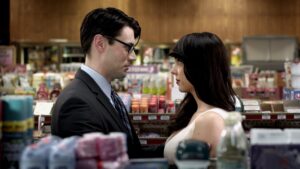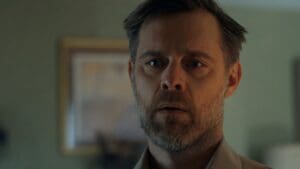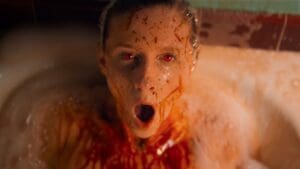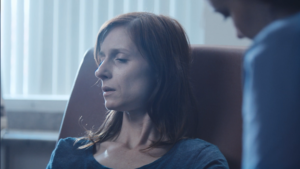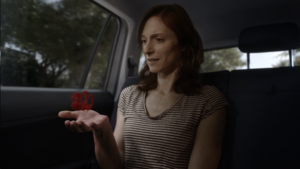Interview with Filmmakers Terry and Larry Ziegelman: “Committed,” “Little Man of Steel,” and “Broken Vessels” (2024)
Accomplished filmmakers Terry and Larry Ziegelman’s horror/thriller short “Broken Vessels” captured my imagination at this year’s Miami International Science Fiction Film Festival (and also captured the award for best actress in a short for lead Alicia Blasingame). “Broken Vessels” takes a dark, unusual look at superheroes, as do the brothers’ shorts “Committed” and “Little Man of Steel,” so here we discuss all three.
“Committed”
“Committed” explores the complex, chaotic and kooky relationship between two popular DC comic characters, the Joker and Harley Quinn, as well as the unseen third person always seeming to get in between them. This multi-award-winning fan film stars Aaron Gaffey as the Joker, Brandi Price as Harley Quinn, and Matt Stevens as the hapless doctor. “Committed” was the proud recipient of multiple honors, including Best Fan Film for both Dragon Con Film Festival and the Superman Celebration Film Festival, Best Screenplay at LA Shorts Awards, Best Actor for the LA Shorts Awards, and Best Actress for Superman Celebration Film Festival to name a few. We were honored to screen across the USA, from California to Rhode Island, to even Hawaii.
“Little Man of Steel”
“Little Man of Steel,” a sexy and raunchy romantic comedy directed by award-winning filmmaker Larry Ziegelman, had its West Coast premiere at the prestigious 16th Annual “Dances with Films” Festival. It won multiple awards at the St. Louis Filmmakers Showcase, including Best Comedy as well as Best Fan Film at Atlanta’s DragonCon Film Festival. It has also played in festivals in New York, Los Angeles, St. Louis, Atlanta, Chicago, and Miami. Please enjoy watching the film that ComicBastards.com calls “…possibly the best Superman fan film you will ever see.”
“Broken Vessels”
While fighting a deadly blood cancer, Jane contends with the effects of “chemo-brain”, attempting to discern reality from fantasy, as she summons up her newfound strength to face-off with an abusive husband. “Broken Vessels” stars Alicia Blasingame as Jane, Cathy Vu as her new “super” friend, Naomi, and Aaron Gaffey as Scott, Jane’s husband. “Broken Vessels” has screened in numerous festivals in Los Angeles, Chicago, St. Louis, Miami, Jacksonville and will soon screen in Seattle and New York, too!
The Interview
“Committed” (A Film by Terry Ziegelman)
1. Bad Guy Fandom. These days fans of various superhero universes seem to have at least as much interest in villains like Harley Quinn and The Joker as they do in heroes like Batman. Why do you think that is? Do you think Harley Quinn and The Joker make more interesting film subjects than Batman? Why or why not?
TZ: In my opinion, the fascination of the “bad boy” and “bad girl” began way before the comic universe. Whether it’s Dionysus or Medusa in Greek mythology, Iago or Lady Macbeth in Shakespeare, the interest in being bad permeates literature. There’s something about being free from the norms of polite society, the willingness to do whatever your heart desires, at any given moment that captures our attention, and allows us to live vicariously through those characters.
Comic book culture simply continues with this age-old fascination. Not surprisingly, I grew up reading comics, and it was hard not to empathize with certain villains. Magneto is a wonderful example of when a villain is fully fleshed-out; you understand his motivations and care about his cause. Even my nine-year-old son, Blake, is familiar with the concept of an “anti-hero.” A great character or anti-hero has so many shades of gray, Deadpool, Tony Soprano, or Walter White, to name a few from recent pop culture.
Are The Joker and Harley Quinn more interesting than Batman? That would depend on the reader/viewer. Perhaps the reader/viewer who is disillusioned with where we are as a country is looking for a hero that stalwartly upholds the ideals of the heroic Batman, or maybe a reader who wants a “walk on the wild side” will enjoy the chaos of The Joker and Harley Quinn.
2. Criminally Coupled. The song that plays over the end credits mentions Bonnie and Clyde, whose relationship is a possible forebear of the relationship between Harley Quinn and The Joker. Why is the criminal couple such an enduring figure in American popular culture? In your film Harley Quinn and The Joker’s relationship combines sex and violence—The Joker is abusive, but the film emphasizes joy in their connection. What’s significant about their violent sexuality?
TZ: Thank you for noticing the end credit song! Curtis Cameron wrote that wonderful song, and it makes me happy to hear it every time. It’s just so smart, funny and easy on the ears! The answer in regards to the enduring quality of the criminal couple is very similar to the bad guy/ bad girl mystique. They live a life of danger and criminality, and we get to ride along for free.
Colin Costello, the creator and co-writer of “Committed,” and I are referencing the long and tangled history that The Joker and Harley Quinn have in both the animated series and the comics. Without a doubt, it’s an abusive relationship, but Harley is so in love, she either can’t see that, or she interprets pain as love. However, since she’s the psychologist, she would be better suited to answer that question.
3. Therapy? Perhaps the hero of the film is the therapist, who makes great strides with Harley Quinn and The Joker during a single session… but he seems a little ridiculous trying to do so. What’s the film’s take on therapy, especially for a couple like this criminal pair? How seriously does the film take Harley Quinn and The Joker as people with mental illnesses? Ought they be committed for being committed to each other? Why or why not?
TZ: My approach to “Committed” from the beginning was always, these are simply two people in couple’s therapy that just happen to be The Joker and Harley Quinn. I wrote it from that perspective, which is why the inclusion of jokes of everyday annoyances between couples arise, albeit, to the level of this criminal duo. I feel it adds a layer of relatability for audience members.
The casting of Dr. Leslie Thompkins, wonderfully played by Matt Stevens, was an interesting dilemma. During casting sessions, many actors in their later years showed up for the role, and they were amazing. However, I was concerned that the audience would bond too much with the wise, old grandfather type, and feel upset if any harm would befall him. So I needed a younger actor with comedy chops that the audience could identify with, but not too much, otherwise, that could kill the funny.
The good doctor has his task cut out for him: to “cure” the criminal pair within one therapy session. As the director, another concern of mine about the session was that people sitting on a couch talking, even The Joker and Harley Quinn, can easily be boring. So it was important to keep things lively and give them fun, physical activities to do, like the “trust fall.” Although, because it is a dark comedy, it’s still a light-hearted take on couple’s therapy, and in no way should any conclusions be drawn about the efficacy of therapy for those criminally insane. However, I would say that therapy is now more important than ever, especially after the pandemic.
“Little Man of Steel” (A Film by Larry Ziegelman)
4. Longstanding Questions. “Little Man of Steel” explores a longstanding philosophical debate about whether Superman could have sex without his super-ejaculation hurting, perhaps even killing, his partner. I don’t want to spoil where the film goes with this debate, so I’ll ask about both sides. Why might super-ejaculation be damaging to Superman’s partner? Alternately, how might Superman avoid damaging his partner when he ejaculates?
LZ: Clearly, I’m not the first Superman fan to theorize the potential dangers of Superman’s sex life. In fact, another “Larry”, Larry Niven, wrote a piece on it called “Man of Steel, Woman of Kleenex.” I discovered this article after my co-writer and I shot the film. I would highly recommend reading it or listening to Bronson Pinchot narrate the audiobook! What I can summarize is the fear of “super-sperm” riddling a woman’s reproductive system with holes as they are ejected out at supersonic speeds and swim up and/or through the Fallopian tubes. This would most likely cause irreparable damage and, most surely, death. So, what’s a poor, horny Kryptonian to do? And that’s where my story begins.
To answer the second half of the question, well…he can’t. At least not with a human. We explored ideas of kryptonite laced condoms. But would that just kill him or at the very least, make him, ahem, soft? The best solution would be for Superman to create a room that would emulate the rays of the red sun, thus, losing his powers. And then, no longer be a superman. But where’s the fun in that?
5. Super Sexy. Your film asks an even more fundamental question. Batman, Superman, and Wonder Woman all have their love interests, but except for some kissing, their relationships seem far more conceptual than sexual. Is it time for us to see these characters as actual adults with sexual identities, even if, as Lois speculates at one point in “Little Man of Steel,” that identity happens to be asexual? Is your film a call for more adult superheroes? Are you taking a step in that direction, leading the way?
LZ: Well, how I’d love to take credit for creating a more “adult” superhero story! But I have to say I was inspired by The Incredibles. I loved how they made two superheroes just another suburban couple dealing with their marital woes and their family problems. Yes, my film takes that a step racier for sure. But movies like Deadpool really created a trend for adult themed super-stories as well as shows like The Boys and Gen V. And I’m so glad they did. Comic book nerds like my brother and myself were raised on superhero stories, and while we get older, it’s nice that those stories are maturing with us. Of course, I’m not looking forward to the stories of superheroes dealing with their swollen prostates, incontinence and hot flashes just yet.
6. Open Secret. About your version of Superman’s world: Lois seems to know who Clark is, and Clark seems to use super-speed in his Clark persona where other people could see him. Is Clark totally “out” as Superman? Does his ability to be open about his (formerly) secret identity relate to his ability to be open about his sexual desire? Why or why not?
LZ: In the world of “Little Man of Steel” we have a Lois that knows that Clark is Superman. We decided that she either used her journalistic powers and figured it out, or that Clark revealed it to her. But they do keep the secret to themselves. Did Clark use his superpowers a little recklessly this one particular evening? Absolutely. But perhaps any surveillance footage might have been destroyed by the end of his date. Is his secret safe with the Pharmacist? Only time will tell.
“Broken Vessels” (A Film by Terry and Larry Ziegelman)
7. Dark Undercurrents Erupt. “Committed” and “Little Man of Steel” both have their dark sides, but when you two joined forces and created a work with characters entirely your own, you went way dark. The other two films are closer to comedy than horror, but even though it deserves to be considered alongside your superhero films, I wouldn’t hesitate to call “Broken Vessels” horror. Why did you turn to darker material as you left the world of DC fan fic? How have audiences responded to the film’s combination of a somber tone with tense, believable scenarios and inspirational insights? Do you see a dark streak continuing in your future work? Why or why not?
T&LZ: For us, “Broken Vessels” has always been difficult to categorize. We’ve had discussions about exactly what genre category it actually belongs in. It checks boxes in superhero, fantasy, sci-fi, thriller, horror and even psychological drama. And in fact, we’ve submitted the film into many different purely genre film festivals, and it’s actually only gotten into one sci-fi and two superhero/geek film festivals. All the rest have been more all-genre film festivals, in the short film category.
We’ve been working on comedic short films and web series for many years and wanted to try our hand at a different genre. Films like Unbreakable, Carrie, and even Sleeping with the Enemy were all inspirational to us as we were writing the screenplay. We are all just fragile vessels holding 1.5 gallons of blood, hoping not to get stuck by a sharp object and start bleeding out. If you think about it that way, it’s truly a fine line between life and death. So with Jane’s blood powers, it really lends itself to a darker, more visceral story.
The audience reaction has been very positive. Often when you sit with the audience, you don’t watch the film anymore, you watch the audience. You notice the scenes they laugh at, gasp at, and, at the end, cheer at. The ones that come up to you afterward are the viewers who are moved by it. They enjoy the VFX, the twists and turns, the emotional scenes and finally the retribution.
It seems that our films have often dealt with themes of life and death and continue to do so. Larry just shot a romantic comedy short that takes place in a cemetery at night. And together, we just wrote a comedic pilot called “Mort ” about a timid actuarial that is accidentally visited by “Death” a day early. So yes, we are continuing our dark streak!
8. Bloody Fantastic. Jane, the protagonist, has a relationship with blood that creates opportunities for dazzling special effects. Where did your ideas about blood in this story originate?
All three films look like they have high production values. I’m about to treat your styles as if they’re very similar—is that fair, or do you see significant differences in the ways you make movies?
As for the similarities, all three films expertly frame close shots to build characters while maintaining immersive senses of carefully colored spaces through longer views and almost seamless editing. That’s my take, but enough about me. Be more specific: what is the “look” of “Broken Vessels,” how did you work together to create it, and how does it relate to the Ziegelman brand?
T&LZ: Thank you for your kind comment about the special effects!. Terry did most of the VFX compositing over the course of three and a half years, supervised by Marvel MCU veteran Bob Homami.
In terms of the origin of the story, we’d have to flashback to our junior high years in the early eighties, where we’d either be fantasizing about casting the perfect actors for an X-Men movie or coming up with our own superheroes and villains. Jane, our protagonist in “Broken Vessels,” is based on our character, a very deadly assassin, named Bloodbath. In a cheeky nod to our Bloodbath character, we added the important bloody bath “rebirth” scene. We would note this character was created way before Bloodbenders from Avatar or Marie Moreau from Gen V!
In terms of our style of moviemaking, we both arrive at similar styles, but from different paths. We both set the bar high for production values. Larry has a background in advertising and is used to high production values from making expensive, live action commercials for clients such as McDonalds, Anheuser Busch, Dell Computers, etc. Terry has classical art training and has worked since 2002 in feature animation for Blue Sky Studios, Sony Imageworks, and Dreamworks, so also has high expectations for production values. We should also note that during the course of any solo project, we frequently reach out to each other for comments and ideas, so it is rare that our opinions are not shared, thereby affecting the solo effort in some minor way perhaps.
In regard to our differences, in the script writing process, Terry can be more verbose in dialog, while Larry leans toward a more terse, tighter dialog. On shooting days, Larry is normally hyper-focused on performances, while Terry focuses on the visuals, lighting, mood and composition to emphasize those performances. Terry is also more knowledgeable about what is best done in post-production and VFX, while Larry is more experienced in the area of editing. In this way, our differences complement each other.
We’ve collaborated together since childhood. We have a shorthand, and usually agree. However, if we don’t agree, we argue it out, until we can convince each other of our side. The only difference now is that our projects are more expansive and expensive! While Terry did the initial script, we both worked on subsequent versions to improve it. We storyboarded together. Larry took photos, while Terry hand-drew frames, and then we pieced them together. Larry edited 85% of the movie, while Terry gave notes. Terry created the composited VFX scenes, and Larry gave notes.
In terms of the look of “Broken Vessels,” we both pulled references for the locations, remembering the emotions we were going for: isolation, sterility, helplessness, loneliness, connection and ultimately, empowerment. Those references were then used as inspiration for color grading, expertly done by Carbon.
We hope our “Ziegelman” brand is slightly dark and geeky, with a high production value, a smart, tight, surprising script, and solid performances. And often funny, if called for.
9. Adult Empowerment. A commonplace (positive) criticism related to superhero storytelling is that the empowerment of lead characters helps young viewers (and readers) feel empowered to find their own identities and greater security in the world. Although it offers little to offend, “Broken Vessels” deals with cancer and domestic violence, not typical youth market fare. I see it as a film for adults, but it still deals with empowerment. What is superheroic for adults?
Why might adults need empowering images just as much as younger people—and how do you think adult-oriented images should look by comparison? All three films we’re discussing put characters related to superhero fantasy into unusually realistic and grown-up situations, the first two to mostly comic effect, “Broken Vessels” to darker but also more profound ends. I’ll rephrase an earlier question: do you see yourselves bringing in a new type of mature superhero film? Why or why not?
T&LZ: We would argue that adult themes and stories have been around since Stan Lee started taking control at Marvel. As kids we read comics that had complex and flawed characters in very mature story lines, like Magneto in the X-Men series. During the Golden Age of the 80’s there were comic series like The Watchmen by Alan Moore and The Dark Knight Returns by Frank Miller that appealed to adults and kids alike. They really opened our eyes to what a comic book can do. Think of Maus by Art Spiegelman, telling the story of Nazis persecuting Jews through the art form of comics.
Empowerment is needed for any age or race that is being put upon and treated unfairly. Now more than ever, adults need reminders of right versus wrong, good versus evil. Think of some recent social movements that empowered us: #metoo, #blacklivesmatter, etc. Just because we’re getting older doesn’t mean we don’t need creative reminders to do the right thing and follow our better angels.
I’d love to say that we are ushering in a more mature superhero film, but rather, we are simply telling stories that interest us, and hope to bring the audience along for the ride.
10. Access! How can readers learn more about you and your works (please provide any links you want to share)?
TZ: Readers can learn more about Terry Ziegelman, his movies, and see his traditional painting as well, through the website, www.terryziegelman.com and on IG: @TerryZiegelman.
LZ: You can find all of Larry Ziegelman’s short films, web series and commercials here: larryz.com/director
And follow his latest on IG: @ugspugspictures
About the Filmmakers
Larry and Terry Ziegelman were born (9 minutes apart) and raised in St. Louis, Missouri. While they were not connected by the hip, they might as well have been. They did everything together when it came to creativity: drawing, painting, creating superhero stories, acting and even co-directing one act plays in high school.
For his undergraduate studies, Larry received a degree in Art Direction, and then he went into advertising, where he created prizewinning campaigns and Super Bowl spots at DDB Chicago. Though he loved thinking of the ideas, he soon discovered that he loved directing them even more. So, for the last few years, Larry has been directing commercials along with creating his own celebrated short films, web series, and music videos.
As for Terry, he earned a degree in illustration. For his graduate studies, he focused on technology and received a Master’s degree in Computer Animation. He has been in the animation industry ever since, working on memorable feature films such as Robots, Ice Age, Cloudy with a Chance of Meatballs, and Puss in Boots: The Last Wish. In addition, he has also written and directed his own highly lauded short films.
Like they did during their childhood, they are still collaborating—just this time, by creating original and award-winning short films. Each of their unique work experiences and talents meshes as they use these skills to push their inventive narratives forward.
Andrew’s Review of “Broken Vessels”
Written and directed by Terry and Larry Ziegelman, “Broken Vessels” tackles somber subjects far from usual horror fare: cancer and domestic violence. The film begins with the terrors of a chemotherapy infusion, which Jane, the lead, faces with quiet dignity, and gradually reveals more about Jane’s struggles with an elusive form of blood cancer and a husband who abuses her verbally, emotionally, and physically without regard for her weakened state. Jane’s situation is horrifying, and the film builds tension and suspense as it unfolds. Taking full advantage of how sympathetic and likable Jane is as she faces such adversity, the Ziegelmans create a rich emotional world.
Much of this richness of feeling stems from Alicia Blasingame’s exceptional performance as Jane. Her highly emotive facial expressions, enhanced by well-framed close cinematography by Daniel Gomez Bagby, tell much of the story, conveying her dread of the needle involved in her chemotherapy and, more deeply, her dread of her husband, revealing his abusiveness long before it appears onscreen. The other actors provide excellent support, with Aaron Gaffey playing her husband, Scott, as believably creepy and revolting, and Cathy Vu playing her partner in chemotherapy, Naomi, as an inspirational voice who dresses as Wonder Woman and Batman as she fights stage four colon cancer. Naomi says at one point, “Cancer makes you strong, a fighter,” and though Naomi’s costumes make her look the fighter part, the film makes clear that Jane has an enormous well of strength. Indeed, simply surviving both cancer and Scott makes her a hero.
The title, “Broken Vessels,” is provocative because it refers to several aspects of the story, one of which Jane and Naomi defy through their heroism: though they might at times feel broken, they ultimately refuse to be vessels broken by their illnesses when they choose to fight. If anyone is a broken vessel, it’s Scott, who looks forlornly at a framed news article about his past glories before settling into his abusive patterns.
“Vessels” also refers to Jane’s blood cancer, presumably the blood vessels broken by the mysterious disease, but the film has some tricks to perform beyond its realistically horrifying foundation. As the short runtime progresses—it clocks in at about twenty minutes—a storyline that qualifies as sci-fi or supernatural (take your pick) comes to the fore. Jane has a peculiar relationship with blood that might just work in her favor; it certainly works in the film’s favor, providing opportunities for dazzling effects.
As Jane’s potential grows and the film’s other tensions escalate, subtle, somewhat ethereal music by Ryan McLean becomes increasingly intense, preparing a final conflict that is thoroughly satisfying. There’s an added twist from the notion of “chemo brain”—likely familiar to viewers who have been or been close to someone going through chemotherapy—and knowing that Jane hallucinates, but one way to understand the film is as less of a horror story and more of superhero’s origin story. You’ll have to see for yourself if that idea fits with how the film strikes you.
However you end up feeling about the characters and events of “Broken Vessels,” the film is unquestionably a thoughtful and moving experience admirable for its adroit handling of sensitive subjects. It’s also visually engaging and exciting, likely to meet demands for fun as well as reflection.
